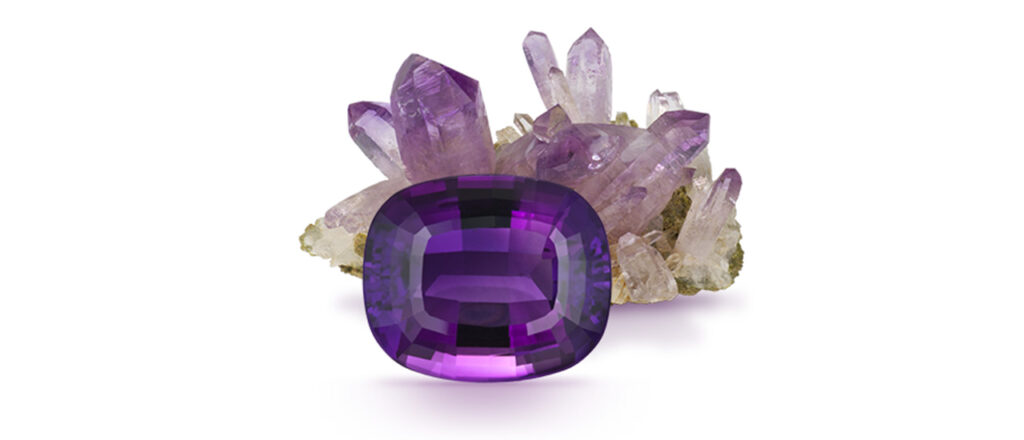February Birthstone
Amethyst
Amethyst, the February birthstone, is the purple variety of quartz and is said to cure drunkenness and make you quick-witted in business. You once had to be rich to own this birthstone for February, but new finds have made it more affordable. Learn more about this stunning birthstone and where it can be found.

If you were born in February, amethyst, a purple form of quartz that has fascinated people for thousands of years, is your birthstone. It may be mined as well as made in a lab, and its lavender to deep purple hues can be cut into a variety of shapes and sizes. The royal dynasties of Asia and Europe have amethyst jewellery in their collections, which is the birthstone for February. Now, the majority of people can afford it. Think about purchasing a magnificent amethyst for the monarch or queen of your heart, or reward yourself with a regal gift. Wearing an amethyst can also be a sign of inner strength and self-empowerment if your birthday is in February.
Meaning & History
The word “amethyst” comes from the Greek phrase “a remedy against drunkenness,” which has long been associated with the purple birthstone as having this effect. Early Greek mythology connected the gem with Bacchus, the deity of wine, because of its wine-like colour. Additionally, amethyst was thought to maintain its wearer logical and astute in both combat and professional situations. It was believed by Renaissance Europeans to calm lovers overcome by passion.
The jewel that is customarily given at the sixth wedding anniversary is amethyst. You’ll be in regal company if you don it in honour of your wedding or as your birthstone for February. Empress Catherine II of Russia (1729–1796), known as Catherine the Great, loved the gemstone and adorned herself with amethyst necklaces, earrings, and other jewellery. Wallis, Duchess of Windsor (1896-1986), a well-known jewellery enthusiast, created a lasting impression in 1953 when she attended a gala in Versailles wearing a pricey amethyst bib necklace fashioned by Cartier.

Benefits
Since at least the time of Alexander the Great, royalty has enjoyed the deep purple shade of the February birthstone. Amethyst lore also makes a number of claims to have mystical abilities, such as bestowing courage and intellect upon individuals who wore it. Wearing an amethyst might be a sign of inner strength and self-empowerment if your birthday is in February.
Amethyst Source
Up until the 19th century, the main source of amethyst was Russia, but then significant amounts were discovered in Brazil. Amethyst, formerly as uncommon as a ruby or an emerald, was suddenly common. Amethyst’s primary sources today are in South America and Africa. Even though the rough amethyst mined in Rio Grande do Sul, Brazil’s most southern state, tends to be a lighter shade of amethyst than amethyst found in other nations, the country is nevertheless a significant provider of the gemstone. Brazilian amethyst from hollow, crystal-lined geodes that are so huge you can stand inside them occasionally forms.
Another well-known source of amethyst is the Anah mine in Bolivia. The Anah mine, which is concealed in the Pantanal marshes, has an intriguing history. It was found in the 1600s by a Spanish conquistador, presented to him as dowry when he wed Anah (a princess from the Ayoreo tribe), lost for three centuries, and then rediscovered in the 1960s. The rare bicolored amethyst-citrine crystals known as ametrine are also found in the Anah mine, which has gained it fame in the gem world.

Zambia’s Kariba mine is one of the biggest amethyst producers in the world, and it is located in Africa. The amethyst that is mined there is frequently of exceptional quality with intense colour.
74 kilometres (46 miles) outside of Phoenix, Arizona, is where you may also find amethyst in the United States. The roughest area of the Mazatzal Mountains is where the Four Peaks amethyst mine is situated. Conditions at the mine are difficult because it is far away, it gets quite hot in the summer, and there is no water or electricity there. However, some very fine dark purple and purplish red amethyst crystals are produced in this rocky, dry, and rattlesnake-infested area.
Care & Cleaning
On the Mohs scale of hardness, amethyst rates a 7. This means that while it is suitable for everyday usage in rings and other jewellery, it may eventually get worn and need to be repolished. You run the danger of scratching your amethyst jewellery if you wear it next to tougher gems like rubies, sapphires, and diamonds because this February birthstone is more prone to damage than these…
The most popular method for enhancing the colour and marketability of natural amethyst is heat treatment. Heat treatment can brighten the colour of very dark amethyst and make it more appealing, but it cannot make pale amethyst darker. In some amethysts, it can also get rid of unsightly brown impurities.
In some amethysts, it can also get rid of unsightly brown impurities. Heat treatment causes some amethyst to become yellow, becoming citrine.
Amethyst undergoes a lasting colour change when heated. It may become a little bit more brittle than typical when exposed to high heat, so take extra care to protect its sharp edges and pointy faceted corners. Also keep in mind that too much heat can completely obliterate the colour and that some amethyst fades over time when exposed to strong light.
This is not a birthstone to wear to the beach every day, even though the colour is steady with regular use.
Ultrasonic cleaning is a viable option for cleaning amethyst birthstone jewellery, but steam cleaning is not advised. The most secure choice is a gentle brush and light soap.
You can also find lab-created amethyst while looking for the February birthstone. Since the 1970s, synthetic amethyst has been known and has the same chemical and physical characteristics as its natural counterpart. Without access to sophisticated gemological testing, it can be exceedingly challenging to distinguish between natural and manufactured amethyst in some situations.
The GIA Laboratory can distinguish between the two, however many in the jewellery industry choose not to request testing due to the expense and time needed to establish the provenance of a relatively cheap diamond. However, retailers are obligated to disclose whether a gem is man-made or natural.

